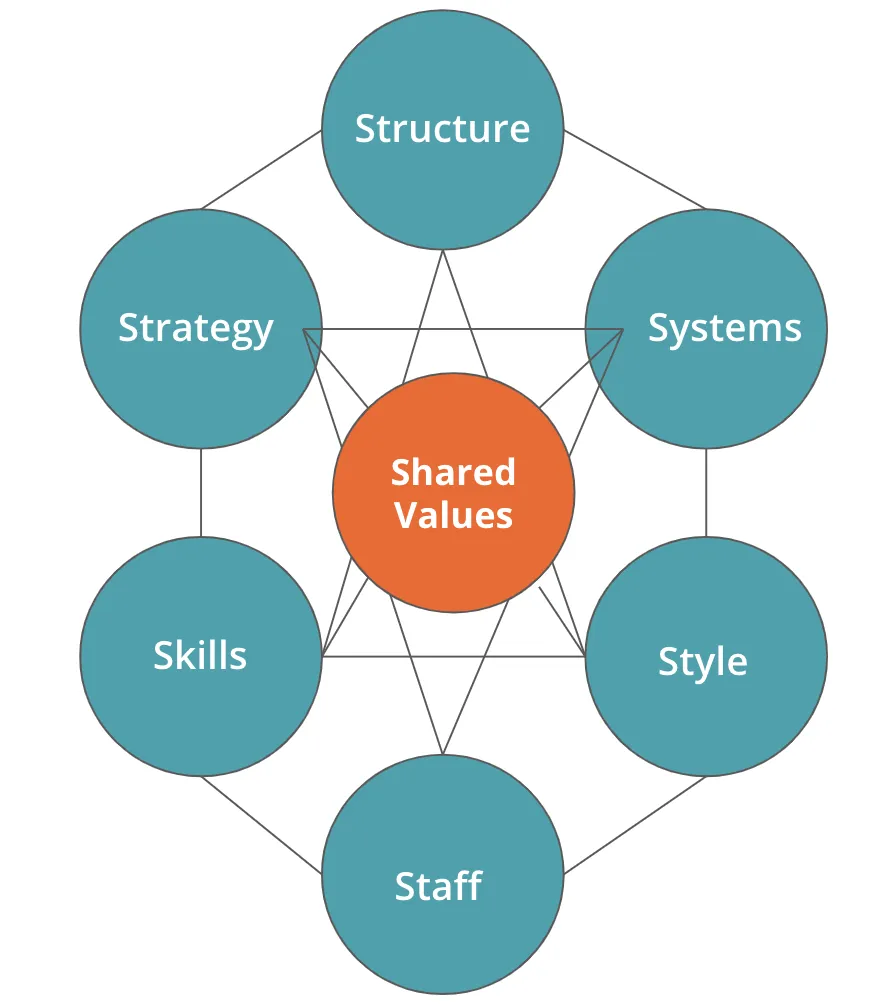By: Kevin L. Noe
The marketing industry is full of diverse people with unique skill sets to build successful marketing and branding campaigns. Those individuals’ professional inspiration is often found outside the walls of an office; creative sparks come from conversations, media, nature, and not the padded walls of a cubical.
Managers of creative teams may struggle if they do not come from a creative background or understand the creative process or the language. Research in this area has looked at variables including environment, the structure of the team’s interaction (individual or community-based), and how the creative process is allowed to transpire. Because, at the foundational level, creative managers are not simply managing creative teams; they are managing creativity. This seems like a daunting task, but in reality, a few simple things allow this process to become more manageable.
Start by looking at your team through the lens of McKinsey’s 7-S model:

If you are a creative manager, it is essential to consider your team and each member with these criteria. Asking if the structure of your team works, and at the individual level, does each person fit within the structure or would they be a better fit in a different place within the team? Next, examine the team’s creative strategy and each individual’s approach to creativity. Is that approach being supported? Working through the 7 parts of McKinsey’s model from a holistic and individual advantage point may allow you to identify the team and individual talents and skills not being utilized to the fullest. I have found that asking team members these questions and giving time for them to think about the answers is beneficial and often provides a different perspective. This process is the first step in developing creative team alignment and synergy.
Team synergy is a resource that has to be managed, and in the creative workspace, a large portion is positioning expertise, creative thinking, and motivation. These are referred to as the Components of Creativity, although viewing these as the creative foundation may be better. First, every team needs creative leadership. This role is not the team’s manager but someone from within the team with a more senior level of experience that can guide the process from within. Someone who understands the vision and is ready to guide and encourage their colleagues through the process; a trusted team member whose criticism is challenging and inspiring, not condescending and harmful. Identify this person for each campaign and carefully provide them the room to be creative leaders without other members feeling micromanaged or resentful. The second component is a unique variable, a mix of pre-existing expertise and current training. Remember, knowledge empowerment is the manager’s obligation to enhance synergy within the team, allowing for maximized production.
Creative team awareness is critical, but once you are aware, what do you do? Recent research out of the United Kingdom examines how to construct a creative team by looking at the creative team’s workspace environment. The first environmental factor is workplace diversity, managers should examine both previous roles and personal backgrounds. Followed by environmental determinants such as appropriate time, space, and resources. This was followed by the technology needed to be successful. All components played a vital role in the construction of branding and marketing campaigns.
The next suggestion may become controversial for some agencies and in-house creative teams. Still, research shows a positive correlation between the creative team members having access to the client and successful campaigns. This open connection allows the creative team to understand the client’s needs, therefore understanding the client’s tone and emotional connection allowing team members the unfiltered context to draw from when building a successful campaign. This organizational structure, guided by a structured framework of roles and objectives, can create a space for creatives to produce outstanding campaigns and strategies.
The key to synergy is to know your team. It is far too easy to place a person in a role because your team has a need. But a well-crafted team relies on members’ natural strengths, not forced roles. When team members work in “their space,” creativity is less likely to be forced and more likely to flow—allowing for creative energy and connection between team members, maximizing the creative process.
About the Author

Kevin Noe has over 20 years of experience in communication, marketing, and brand development for B2B and B2C clients. Currently, he leads Madison Solutions, an Atlanta-based marketing agency specializing in brand strategy, strategic growth, and brand equity maximization.
In addition to his work with brands, Kevin is a featured speaker at conferences focusing on marketing strategy and brand-building. Kevin holds an MBA and M.A. in Public Policy and an M.S. in Marketing from Culverhouse College of Business at The University of Alabama. He is currently completing his doctorate in business administration with a research focus on brand equity and branding.

